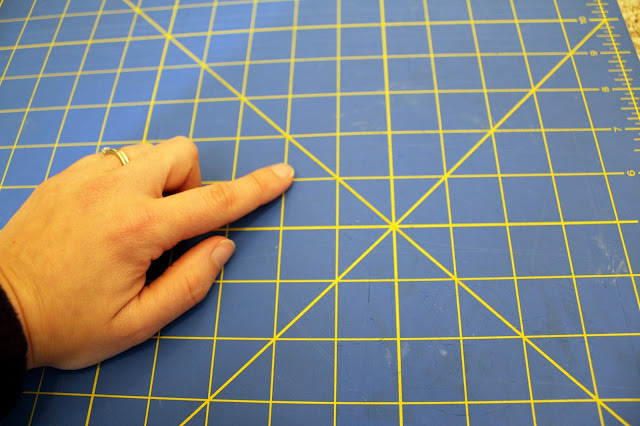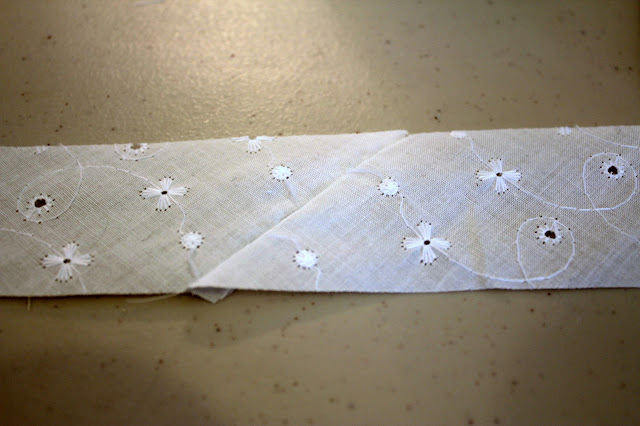Alright, let's finish this project up, shall we? I've already gone through the first two stages of this project. First, I demonstrated how I constructed the face of the panda using a technique called applique, as well as some light embroidery for the mouth. Second, I demonstrated how to make homemade bias tape for the border of the bib. Now that we have all the pieces ready to go, it's time to construct the finishing touches.
At this point, the face of the panda has been attached to the front part of the bib that we have cut out like this:
Line up the two sides of the bib, wrong sides together, and pin to keep in place. Cut through the top part of the bib like this:
Now it's time to begin attaching the bias tape. Disclaimer: This is NOT the proper way to attach bias tape. Traditionally, you would sew on one raw edge of the bias tape with the raw edge of your project, and then top-stitch the rest of the bias tape on. The first bib I made, I attempted this and it was a MAJOR failure! This is such a small, curvy project, that it's damn near impossible to attach the bias tape in the traditional way. I've found that if I simply pin the bias tape in place and top stitch once, it's much easier and less prone to errors. The only downside to this method is it's a little harder to attach the two ends together at the end, which I'll get to. He, I've begun attaching the bias tape around the edges of the bib.
Notice how I handled the corners of the neck area. I've pinned most of the bias tape on, but haven't finished pinning the corners down. When doing this, you can gently pull the bias tape (it has a little stretch) to make the curves lay more flat.
Now let's work on getting the end of the bias tape pinned down. You want to leave yourself about 2-3 inches of extra bias tape that will overlap with where you started. You can see how much I have left here. Take the bias tape that will cover or go over the other side of the bias tape and open up the folds. Make a small fold on the raw edge of the open bias tape that is parallel with the edge, shown here:
Now here's the tricky part: Refold the bias tape along it's previous folds with the new fold still intact. Now you want to "cover" the other edge of the bias tape, tucking the folds under the other bias tape. This is shown here:
This may take some finagling and adjustment, but eventually, you'll want to get everything pinned down and lined up so there's no slack in the bias tape, and there are no raw edges showing. It will look something like this:
Now for the corners. Fold and tuck the corners on both sides of the bias tape so they lay flat. Try to make the front and back as symmetrical as possible, so when you sew it down it will mostly line up with both sides. I've found that pinning separately on both sides is the best way to get it to lie flat, otherwise you're attempting to pin through too many layers of fabric, and that will be difficult to sew later. This is how I pinned down the corners:
Continue top-stitching around the bias tape. Make sure you keep the spacing as even as possible. The kind of spacing I try to maintain is about 1/8" of an inch from the inside edge, and 3/8" from the outside edge of the bias tape. You can see this spacing below. Two reasons for this: You want to make sure your stitches are going through the bias tape AND the face of the bib, so if you stitch too close to the outside edge, you might not get all the layers (which depends on the quality of your pinning). Also, if you stitch too close to the inside edge, you may actually stitch off the edge of the bias tape on the back. (also dependent on pinning) This last point would not be an issue if we were doing bias tape the traditional way, but WHAT CAN YA DO?
Yayyyy, we've sewed on the bias tape!
Now, I've simply attached velcro strips by hand sewing them. Make sure the soft part of the velcro is the one that is facing toward the baby's neck!
Voila! The finished product! Ready for baby!
Thanks so much for visiting. I really appreciate everyone who reads and comments. If you like what you've seen here, please follow me on Facebook and Pinterest to receive updates.


































